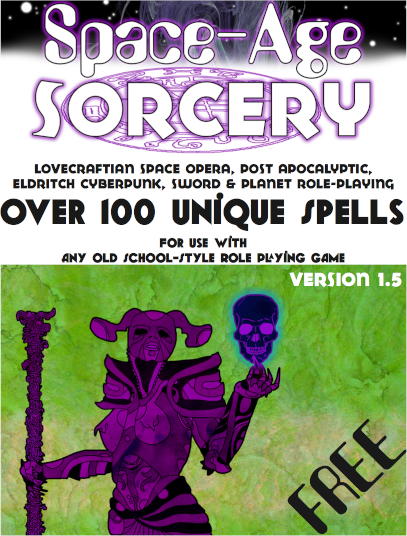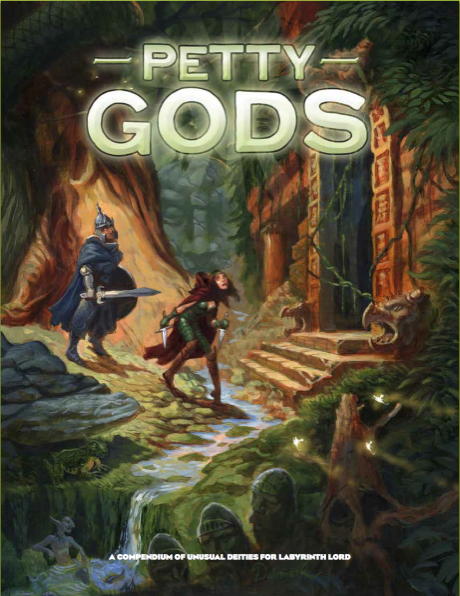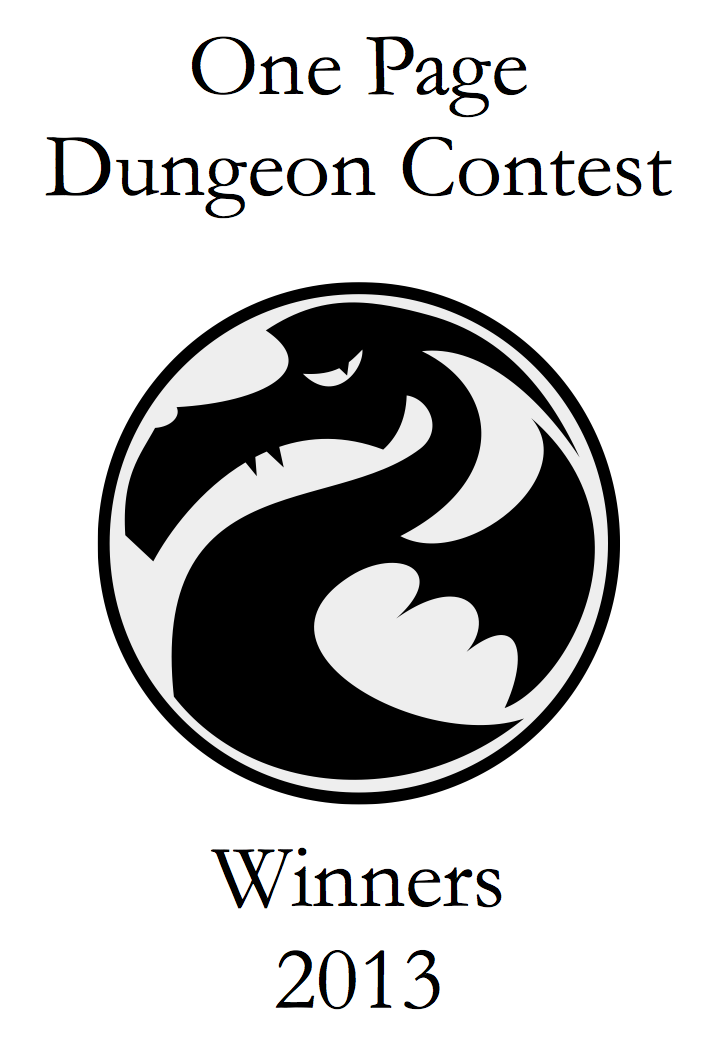Gods, Monsters, Spells, and One-Page Dungeons
Over the last two months I’ve found several intriguing and strange compendiums useful for Gods & Monsters or any old-school game.
All of them, at this time, are free.
Space Age Sorcery
Billed as “Lovecraftian Space Opera, Post Apocalyptic, Eldritch Cyberpunk, Sword & Planet Role-Playing”, Space-Age Sorcery from Hereticwerks claims “over 100 unique spells”.
Many of those 100 names are weirdly evocative, such as Squamosity, Spasm of Horror, and Subatomic Reembroidery.
If you’re looking for some wicked-twisted spells that a cyborg sorcerer from a shoggoth-haunted nuclear waste- land might have on-hand or you want to give the next bunch of foul cultists something with a little more oomph than a few magic missile spells, we’ve got you covered.
The spells themselves are “costly… gonzo batshit terrifying… [and] gross”. They’re categorized as Clerical spells and Magic-User spells; the only stats are spell level, range, and duration. You’ll need to make up any other necessary stats (or pull them from the description) as needed.
The back has a page of 1d6 spell-based scenario seeds, a page of 1d6 random magic items, and a page of 1d6 encounters.
Some of the spells are themselves adventure seeds:
Existential Excision: The caster may remove a noticeable portion of the existence of any one entity, including the caster. Whether this is physical, mental or spiritual in nature is entirely at the whim of the caster. The portion of the victim’s existence that is so removed can be used, bartered, or embedded into some relic or object, even simply consumed, but only by someone other than whomever originally cast this spell.
It’s a work-in-progress, so you’ll want to subscribe to their blog as well. As of version 1.5, Space Age Sorcery has 23 pages of spells and other things. It looks like a great addition to a game that includes both fantasy and ancient technology, with a bit of horror thrown in.
Petty Gods
Subtitled “A compendium of unusual deities for Labyrinth Lord”, the compendium of Petty Gods sports a 2010 foreword from Paul Jaquays and a nice cover by Thomas Denmark. The back section includes an essay by M.A.R. Barker, “Create a Religion In Your Spare Time for Fun and Profit.”
Some of the petty gods within are silly, some petty, and some strange. Aurus Argentus is the god of currency debasement. Azwa is the protector of stone heads in the wilderness. Glorfall is the god of academic arguments. “A tenured professor who prays to Glorfall once a week for a whole semester will receive 2d20x1.7 additional undergraduate students the following semester; and 1d6 additional applications from prospective graduate students.”
Meanwhile, Gnunnug is the god of the number 7. And Nocton Zython is patron of lotus eaters, dreamers, illusionists, and sailors. And so on. It has exactly one hundred entries, because you never know when you’re going to need to generate a random unknown god. To drive the point home, the one-hundredth god is marked “00”, because yes, you are meant to use a d100 on the table of contents.
The book itself is a hundred and fifty pages long: that means that each entry is at least a page, sometimes more. They’re beautifully illustrated; most of them have a customized reaction table utilizing a d6, a 2d6, or a 2d12. The reaction table can be as simple as “Befriend/Ignore/Avoid”, for Bashiuus (petty god of wine and merriment), and as detailed as the “Reaction Table for Heptagonal Blasphemies” from Chulg, petty god of heptagons?
The propitiation of Chulg was undertaken by worshippers whose origins are lost in deep time. Its manifestation seems also to be associated, to a lesser extent, with the breaching of certain taboos regarding heptagonal objects. Since few understand the specific conditions that will incur Chulg’s attention, judicious avoidance of heptagons is often held to be the best policy.
Many of the entries are little more than high hit-point imps, such as Fluxalle, who causes havoc in kitchens as the “god of corroded cookware and brewing gone bad.”
This book is huge. If you like the strange and unusual, you are going to find something to use in here. Definitely worth checking out.
Lord Gwydion’s Beast of the Week Collection
In his Beasts of the Week Dennis Laffey has created a bunch of monsters imported from other sources, including medieval demonology, the epic of Gilgamesh, and the Big Lebowski.
Bumbles are 12-15' tall hairy white monsters that live in Arctic climes. They have strong claws and wicked looking teeth, but because of their poor dental hygiene, their teeth often rot so they rarely bite. While they are not overly aggressive in normal times, when they have a toothache they are touchy and may attack any creatures that disturb them. Bumbles are immune to all falling damage—they bounce!
Fire Breathing Dungeon Chickens are similar to normal Dungeon Chickens, except they are always red in color.
Space Monkeys are simian creatures from another world. They are extremely agile and their long prehensile tails can be used for many purposes. They are intelligent, but speak only their own strange language of grunts, hooting, and cries similar to that of normal monkeys. Space Monkeys may become fond of certain heroic individuals or duos, and serve them.
Dennis also recognizes the importance of Sleestak. At twenty-five pages of short descriptions, the Collection includes approximately seventy-two creatures. It’s unlikely you’ll want to use all of them—they range in seriousness from Chicken Legs to Stygian Baboons, green Slimers to Demon Dogs. And they range in power level from tiny 1 hit die bitterflies, to 12 hit dice Saurons, and more. But if you’re looking for something odd, memorable, and vaguely familiar, you’ll probably find something useful among these beasts.
Varlets and Vermin
I like Varlets and Vermin because author Roger S. G. Sorolla recognizes the gaming potential of the prehistoric horned gopher, though he merges them into a general class of “Miner Rats”.
Because the book is meant to provide challenges, it is divided into sections like “garbage dumps”, “three feet of water”, and for the really weird stuff, “adversarial gamemaster’s bullpen”. The idea is that these are short adventures, not just monster entries. You can take an empty map, put terrain on it, including dungeon terrain, and then choose something from “at the entrance”, then “the underdim”, and maybe something from “pauper’s cemetery” to create a simple adventure for low-level characters, specifically for first-level characters.
Barrel Beast: An innocent looking barrel can come to be stuffed full of the infamous barrel beast in the same way that a deserted shell is taken over by a hermit crab. One end of the barrel is missing, and this end sits on the floor while the beast watches through a knothole. When a living being approaches within 5 feet, the beast rears up on its long, clam-like, prehensile foot and clobbers the victim with the barrel, doing 1d4 damage on a successful hit, and knocking him or her down unless a save is made.
Man of Wounds: When found, he will have 2 or more weapons stuck in or to his body, with a hit die for each rolled according to the damage dealt by that weapon – so, a 1d4 dagger, 2d4 maul and 1d6 sword would give him three effective hit dice and 3d4 + 1d6 hit points. Any weapons that hit him stick to him; roll damage, and add that to his hit points, then add 1 to his hit dice. The only way to harm the Man of Wounds other than magic is to grab his weapons (on a bare-handed hit vs. AC 5) and pull them out of his body, dealing damage equal to the weapon’s hit die roll and reducing his Hit Dice by 1. When all his weapons are gone, the Man of Wounds’ enchantment is broken, and he falls to the ground bleeding with zero Hit Points.
Skull Creeper: Sometimes, a necromancer who wants skeletal servants that can fit into tighter places will wire a human skull onto two sets of hand bones, creating an unnerving, spider-like scuttling thing.
He’s written it for Swords and Wizardry, but they’ll work in any D&D-like game. And some of it are just ideas for cool effects, such as the dust of ages. Take a look at it. It’s filled with great ideas for introductory adventures.
One Page Dungeon Contest
The contest has been running since 2009. I’m far too wordy to enter it, but I have no problem stealing from it. The 2013 winners collection is worth downloading, and it’s a good idea to look at the full entrants, too. Everyone’s tastes differ and your tastes may well differ from the judges.
The one-page dungeon is, literally, that: a dungeon that fits on one page. It includes none of the niceties of modern dungeons: no full stat lists, you’ll need to create them on the fly or use the monster books for whatever game you run it in; no flavor text, that’s up to you. But on the plus side, there’s almost no way you can forget to apply some part of the dungeon, because you have the entire dungeon right in front of you, with descriptions. There is no page-flipping in a one-page dungeon.
Some of them try to use tiny text, but just as often they use large text and even make use of white space.
Some adventures are strange, such as The Girly Girl Dungeon which needs to be printed in color for full effect. It’s “an adventure that can be defeated by 1st level girls or 5th level boys,” and judging from the encounters the tagline is probably correct. Other adventures are extremely vague, such as The Iron Cloud, which contains “Orgotron the robot overlord—grafts robo parts onto creatures to control them.” How does he do it? What are the effects? That’s left up to the game master! But you can’t go wrong with an adventure that includes flying vampire squids!
Others are good solid dungeons, like The Brittlestone Parapets, “three miles of ragged magic-torn trench… a warped, dangerous scar that lures treasure hunters seeking strange magics and wealth abandoned.” Or The Burial Mound of Gilliard Wolfclan, where Old Tooley tells you, “Way back when, the barbarian chief Gilliard Wolfclan trucked with evil spirits and went mad. His clan killed him and buried Gilliard and his followers… there’s been weird noises comin’ from inside the mount lately.”
Download the full set of non-winners as well. Some of my favorites from the non-winners are Brewer’s Backwoods with its “fearsome critters, strange flora, and fabled treasures” and Miscegenation of the Ancients where the adventurers investigate “an inexplicable, vaguely ship-shaped gopher-wood construct on top of a mountain peak in the highlands.”
- Lord Gwydion’s Beast of the Week Collection: Dennis Laffey at What a Horrible Night to Have a Curse
- “Monsters for Classic Fantasy Role-playing Games involving underground complexes and large flying reptiles collected from the blog What a Horrible Night to Have a Curse…”
- One Page Dungeon Contest
- From 2009 up, the One Page Dungeon Contest entrants and winners.
- Original Petty Gods Free PDF at Gorgonmilk
- “Here it is—the long-believed lost version of PETTY GODS designed by Peter Gifford and edited by James Maliszewski of Grognardia! To keep things straight, we’re officially dubbing this ‘OPG’—Original PETTY GODS—while the ongoing book project I’m editing will hence be known as ‘XPG’—Expanded PETTY GODS.”
- Paul Jaquays
- “Paul Jaquays’ early career is best defined by his designs for RPG adventures like Dark Tower and Caverns of Thracia for Judges Guild and Griffin Mountain for Chaosium. As eventual Director of Game Design at Coleco, he had a hand in nearly every video game coming out for ColecoVision and the ADAM Computer.”
- Space-Age Sorcery at Hereticwerks
- “Lovecraftian space opera, post apocalyptic, eldritch cyberpunk, sword & planet role-playing.”
- Thomas Denmark
- “Visual Designer”
- Varlets and Vermin 1.0: Roger S. G. Sorolla at roles, rules & rolls
- “I’ve always felt the lack of lower level monsters in any setting; but especially the old school with its stripped-down lists.”
More deities
- Do not miss Petty Gods!
- This is a tome worthy of the gods—and that’s what it is. A tome of gods usable much as a tome of monsters, placing these petty gods—what Gods & Monsters would call spirit gods—around your sandbox’s map.
More dungeon
- The Yuma Territorial Dungeon
- The Yuma Territorial Prison looks like a great dungeon setting. It’s history provides inspirational ideas for more fantastic dungeons.
More monsters
- Giant walking tanks that eat everything in their path
- Science News brings us another potential strange creature: a 4,000 pound armadillo the size of a tank, with mace-like spiked tails.
- Giant saber-toothed leaping salmon
- The saber-toothed salmon weighed nearly a thousand pounds and ate adventurers for lunch.




Portions of this post appeared in Alarums & Excursions 453 and 454.